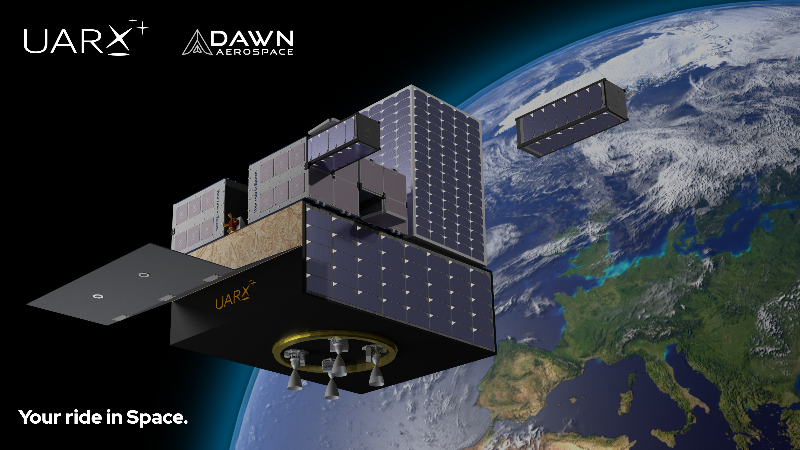 Image credit: UARX Space
Image credit: UARX Space UARX Space, a Spanish in-space transportation services company, has selected Dawn Aerospace as its satellite propulsion supplier for its first OSSIE Mission.
OSSIE (Orbit Solutions to Simplify Injection and Exploration) is an OTV (Orbital Transport Vehicle) - sometimes called a space tug. The spacecraft can transport up to 400 kg of CubeSats, PocketQubes, and other small satellites to custom orbits post-launch.
Dawn will provide complete turn-key green propulsion systems to the OSSIE spacecraft, including thrusters, reaction control systems, and tanks. Having launched fourteen thrusters this year across SpaceX's Transporter-1, Transporter-2, and Soyuz-2, Dawn's nitrous oxide and propylene-based propulsion systems are quickly gaining momentum as a leader in green propulsion and as a commercially viable replacement to hydrazine.
Modular by design, OSSIE can carry a series of RAMI (Reliable and Advanced Mission Injector) deployers for CubeSats. Each RAMI deployer has the capacity to deploy up to 12U-XL. Uniquely, these deployers enable customers to communicate to their spacecraft and charge batteries during transit as well as providing a maximum of 20mm of protrusions, the best in class.
"With their series of space-proven components, Dawn's modular system is designed to grow as we grow," said Andrés Villa, CTO at UARX Space. "They have all the building blocks and thrust levels we need, allowing us to scale systems as needed, up or down."
In-space propulsion systems are equipped with thrusters (small rocket motors) that form part of the satellite itself. They allow satellites to maneuver in space after their initial boost onto orbit. Thrusters serve several functions; they can perform corrective maneuvers if a satellite has been delivered to an incorrect orbit, they can orientate a satellite, can be used for collision avoidance, and can carry a satellite further afield, for example, to a higher orbit or on a mission to the Moon or another planet.
"We are excited to be selected as UARX space's propulsion partner," said Jeroen Wink, Co-founder at Dawn Aerospace. "This is just the start of what we aim to be a very long and productive relationship. We're looking forward to the future with UARX!"
OSSIE is scheduled to launch in early 2023, following an initial demonstration mission slated for 2022. Other named parties to the project include DLR, the German Aerospace Center, who signed a Cooperation Agreement with UARX last February.
UARX Space is a Spanish company developing in-space transportation services from Low Earth Orbit to the Moon and beyond. UARX founders are California Polytechnic State University alumni, the worldwide known "home of the CubeSats." In addition, the UARX Space Team is formed by experienced aerospace professionals with a background in designing geostationary satellites, scientific Earth observation missions, and payload instruments for deep space. Their expertise includes critical onboard software, structural analysis, thermal analysis, project management, systems engineering, assembly, integration, and testing, among others. The company is headquartered in Nigrán, Spain, with an office in Mar del Plata, Argentina.
For more information visit www.uarx.com
Dawn Aerospace, seated in both the Netherlands and New Zealand, is a space transportation company; providing in-space satellite propulsion to its customers globally and developing a same-day reusable spaceplane. Dawn's propulsion technology achieves similar performance to traditional hydrazine systems by using a unique, green-propellant combination; nitrous oxide and propylene. Having proven this technology on-orbit for CubeSats and Small Satellites, Dawn demonstrates that operators can apply this technology to satellites of all sizes. The company has also confirmed that high-performance chemical propulsion systems can fly on packed rideshare missions, having done so on VEGA, SpaceX's Transporter-1, Transporter-2, and Soyuz-2. On December 9, Dawn announced that the New Zealand Civil Aviation Authority (CAA) granted the company an Unmanned Aircraft Operator Certificate to fly their suborbital Mk-II Aurora spaceplane from a conventional airport without exclusive air restrictions.
For more information visit www.dawnaerospace.com